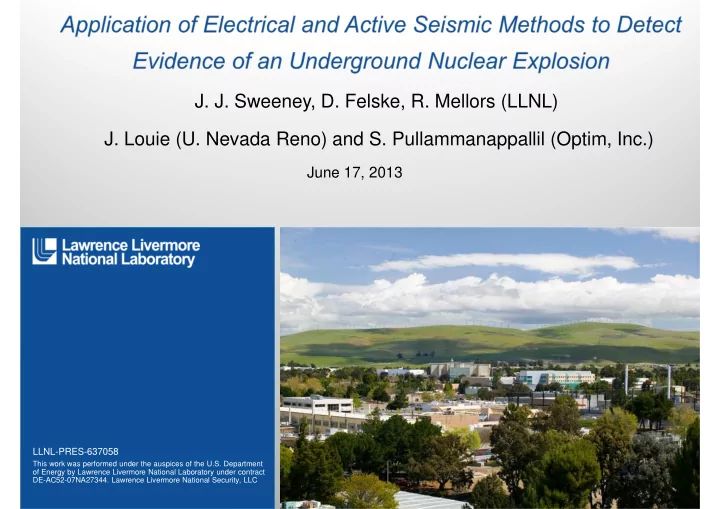

J. J. Sweeney, D. Felske, R. Mellors (LLNL) J. Louie (U. Nevada Reno) and S. Pullammanappallil (Optim, Inc.) June 17, 2013 LLNL-PRES-637058 This work was performed under the auspices of the U.S. Department of Energy by Lawrence Livermore National Laboratory under contract DE-AC52-07NA27344. Lawrence Livermore National Security, LLC
The work presented here was made possible through support of the United States Department of Energy, National Nuclear Security Agency. The views expressed here do not necessarily reflect the views of the United States Government, the United States Department of Energy, or Lawrence Livermore National Laboratory. Lawrence Livermore National Laboratory 2 LLNL-PRES- 637058
On Site Inspection Continuation Period of the CTBT begins after the initial inspection period (up to 25 days duration). Some inspection techniques can only be used during the Continuation Period [active seismic, resonance seismic, magnetic, gravity, and electrical methods] — the so-called Continuation Period Technologies (CPT). CPT can be divided into shallow and deep methods; shallow methods are commonly used in environmental, archaeological, and resource studies. The objective of deep CPT methods is to detect an anomaly caused by a possible underground explosion (deep rubble zone or cavity). There is little experience with using deep CPT methods to look for anomalies caused by explosions Lawrence Livermore National Laboratory 3 LLNL-PRES- 637058
The goal is to apply electrical methods and active seismic methods over a known underground nuclear explosion (UNE) test location in order to assess their application for OSI. Methods used: dipole-dipole resistivity survey, induced polarization (IP) survey, controlled source audiomagnetotelluric (CSAMT) survey, and an active seismic survey using both shear (S) and compressional wave (P) sources. Lawrence Livermore National Laboratory 4 LLNL-PRES- 637058
High desert climate (Nevada, 2000 m elevation, former nuclear test site) Deep water table (> 600 m depth) Layered volcanic rock (Cenozoic tuff, Tuffs, welded welded and non-welded) and non-welded Relatively flat topography and easy access at surface Test conducted in 1985: Quartz-bearing Working point depth 608 m; rhyolite lavas yield < 150 kT; cavity radius ~ 60 m; no surface crater; rubble chimney estimated to extend up to 200 m depth Lawrence Livermore National Laboratory 5 LLNL-PRES- 637058
Dipole-dipole and IP are useful for tracking the depth to the saturated zone down to ~ 200 m. These methods were not expected to see effects of the UNE; we wanted to study the “noise” environment of a test location (effects of well casing, cables lying on the surface, other artifacts). CSAMT can “see” to depths of up to 1000 m or more, but resistivity contrast was not expected to be very large in rubble zone. Resistivity of a cavity immediately after a UNE test may be much different — there may be a conductive anomaly due to presence of hot fluids and steam, but this will be much different 28 years later. Lawrence Livermore National Laboratory 6 LLNL-PRES- 637058
Survey lines for dipole-dipole and CSAMT surveys Dipole-dipole/IP: 20 m spacing, to n = 15 CSAMT: 10 m spacing, current source located 5 km east of site Lawrence Livermore National Laboratory 7 LLNL-PRES- 637058
Dipole-dipole survey results water pipe segments Borehole S-N line; depth resolved is about 150 m casing (GZ) W-E line; depth resolved is about 150 m Lawrence Livermore National Laboratory 8 LLNL-PRES- 637058
W-E CSAMT survey results Borehole wires on casing surface (GZ) Method “sees” to ~ 800 m depth; large effects of emplacement hole casing and wires lying on the surface Lawrence Livermore National Laboratory 9 LLNL-PRES- 637058
Shorter W-E CSAMT line offset by 40 m south from the longer W-E line This still sees some effect of casing Lawrence Livermore National Laboratory 10 LLNL-PRES- 637058
Receivers 3 component 4.5 Hz geophones wireless digitizer and Source internal GPS. Mini-vibe with waffle plate P wave (vertical) Setting shear-wave (transverse and radial [w.r.t line]) Flat topography 5-6 sweeps per location Some weathered tuff at surface Lawrence Livermore National Laboratory 11 LLNL-PRES- 637058
Lawrence Livermore National Laboratory 12 LLNL-PRES- 637058
300 stations Deployment 1 Roughly linear 30 m spacing on line; 40 on cross-lines Deployment 2 Star pattern with circle source Lawrence Livermore National Laboratory 13 LLNL-PRES- 637058
Lawrence Livermore National Laboratory 14 LLNL-PRES- 637058
Data were processed using two types of analysis: � Surface wave dispersion Love and Rayleigh Refraction microtremor � Standard reflection processing Lawrence Livermore National Laboratory 15 LLNL-PRES- 637058
P-P stack S-S stack P-S stack Expected top of chimney Expected cavity Rhyolite lava? No clear reflections or features Lawrence Livermore National Laboratory 16 LLNL-PRES- 637058
frequency/slowness data model dispersion Lawrence Livermore National Laboratory 17 LLNL-PRES- 637058
Above rubble zone Away from rubble zone Lawrence Livermore National Laboratory 18 LLNL-PRES- 637058
Cavity Vs=817 Cavity Vs=905 Lawrence Livermore National Laboratory 19 LLNL-PRES- 637058
� Dipole-dipole, IP, and CSAMT surveys used a 3- person (experienced) crew and took about 6 days each. � Data processing electrical was overnight, or 1-2 days. � Active seismic used a 4-person (experienced) crew and 7 days; processing took several weeks. Lawrence Livermore National Laboratory 20 LLNL-PRES- 637058
1. Dipole-dipole and IP electrical performed as expected — revealed some artifacts (borehole casing, pipes) and good representation of geology. 2. CSAMT was able to image deep enough, but borehole casing masked possible effects of rubble zone. Some artifacts were also revealed. 3. In this setting, volcanic tuff, it was essentially impossible to image a known cavity at a depth of 300-500 m using standard reflection processing. Possibly a more energetic source might work better. 4. Surface wave dispersion did produce a good result. The lateral extent of the cavity was evident but vertical extent (bottom) was difficult to image. Lawrence Livermore National Laboratory 21 LLNL-PRES- 637058
Recommend
More recommend